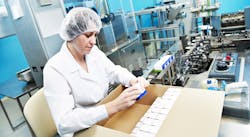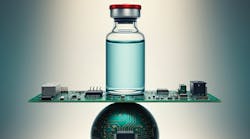3 tech solutions pharma needs in order to comply with changing regulations
Regulations are nothing new to the pharmaceutical industry. They’ve been around since the early 20th century and have continued to evolve ever since, with regulators such as the U.S. Food and Drug Administration (FDA) and the European Medicines Agency (EMA) in the EU ensuring the safety, efficacy and quality of pharmaceutical products.
But the regulatory landscape constantly changes, including increased scrutiny around environmental conditions in the storage and transportation of pharmaceuticals and biologics. It’s imperative to have proven systems and processes in place in order to comply with all requirements.
As a result, Good Manufacturing Practices (GMP) have become a prerequisite for conducting business as the pharma industry works to ensure regulations are implemented and processes are validated. Keeping up to speed with the ever-changing global regulatory environment is enough to make anyone’s head spin — yet it’s non-negotiable when it comes to ensuring ongoing compliance.
How do pharma manufacturers safely move products ensuring against environmental exposures to meet all the latest compliance regulations? It requires new ways of thinking and working —with technology.
Regulations are heating up
While the entire global pharma industry faces regulatory challenges, the U.S. pharma industry in particular is racing to meet the final phase of the FDA’s Drug Supply Chain Security Act (DSCSA) which requires new track and trace tools to comply by November 2023. DSCSA is intended to help protect consumers from exposure to drugs that may be counterfeit, stolen, contaminated or otherwise harmful, as well as improve detection and removal of potentially dangerous drugs from the pharmaceutical supply chain.
Specifically, it requires tracking items, such as containers holding medications, from the manufacturer all the way through to dispensers — local retail pharmacies or hospitals. While there have been milestones of improvements over the last several years, it will culminate when DSCSA is in full effect by the end of this year. Traceability is not only needed to move pharmaceutical products but now also the data that goes with it, establishing a new paradigm for the industry.
No doubt, the U.S. pharma industry is feeling the pressure to meet the DSCSA regulation, leveraging current and emerging tech solutions while working to maintain the speed and accuracy of the supply chain without disruption. There’s no way around (and there shouldn’t be) the need for a fully visible supply chain. After all, it’s about safety. The goal of traceability regulations is to deliver the right products — without tampering or environmental impacts — to people safely. And the industry needs to step into digital transformation to get there.
Case in point, in the past, traditionally a manufacturer could estimate the number of cases on a pallet sent to a wholesaler and that would be good enough. Now they need to know which serialized item is in which case, and which case is on which pallet, even as they’re aggregated throughout the supply chain. And if the data doesn’t align, the products can’t move, causing delays, spoilage and waste. It’s no easy task, but it must be accomplished. With the right tech solutions, the pharma industry can keep up with heightened regulations and consumer demands.
Here are three tech solutions that enable the pharma industry to do just that:
1. Always reliable: Radio frequency identification (RFID)
Barcodes have been the tracking standard, and in many cases still are, for pharma manufacturers. But RFID is a better solution to meet the latest regulations, including serialization requirements. RFID enables manufacturers to capture data throughout their supply chains from warehouses and distribution centers down to the consumer. All items — whether at item, box or pallet level — can be tagged, and with the right infrastructure, read throughout the supply chain journey. RFID provides the ability to capture all required information at once, providing increased speed and better efficiency instantly.
2. Unmatched accuracy: Industrial machine vision and fixed scanners
Machine vision and fixed industrial scanners are an ideal solution for the pharmaceutical production process, especially to meet tighter regulations. With the ability to ‘read’ items, they are fully aware of what’s happening while observing the flow of products, raw materials and goods moving along the production line. Industrial machine vision and fixed scanners raise the bar on quality assurance by delivering exceptional speed and accuracy.
For example, let’s say blister packs are being filled along the production line. Machine vision can assure the packs are being filled accurately, alerting operators of any issues so they can address the problem (i.e. remove the blister pack from the line, stop production, check equipment, etc.). Moreover, machine vision and fixed industrial scanners provide qualitative data, accurately capturing and analyzing it so the right corrective actions can be taken.
RFID, machine vision and fixed industrial scanners are not either-or solutions — in fact, when integrated, they work better together. RFID provides quantitative data, identifying where and how many items there are. Image-based machine vision and fixed industrial scanners share qualitative data, identifying the quality or condition of items, building a repository of data for historical information and manufacturing processes. They are complimentary solutions providing a complete view of required data points when integrated.
3. Connecting with cold chain: Environmental sensors
Cold chain is a $280 billion industry and incredibly important to the pharma industry as well as our daily lives. Just think about all the items you buy that require refrigeration while transported —perishable food, beverages and of course, medications. Yet according to the Zebra Pharmaceutical Supply Chain Vision Study, only four-in-10 pharmaceutical decision-makers say they completely trust the entities within the pharmaceutical supply chain to keep medications safe and uncompromised throughout the supply chain.
Environmental sensor technology can help validate the condition of products hitting shelves and doorsteps by detecting everything from humidity to ambient temperature fluctuations, and alert workers to act.
While environmental sensing technology has been around for years, it has recently matured quite significantly. In fact, there are now printable as well as ready-to-use visual sensors that can be applied to products to reveal environmental excursions via color-changing indicators. There are also electronic sensors that can collect environmental readings and deliver them to the cloud for analysis. In both cases, the data can be actioned in a way that prevents shrinkage from presumed spoilage, preserves your assets, and helps protect customers.
Take shipments, for example. With an electronic sensor’s Bluetooth connectivity, it can log and detect temperatures and if it identifies an item that’s reached an excursion in temperature, it would be staged for investigation rather than going directly into the supply chain, risking expensive, brand-damaging recalls and not meeting regulations. It’s a game-changer.
It's a new way technology can be used in the pharmaceutical supply chain, moving time and temperature-sensitive goods that are highly regulated, catching a wide variety of information, then putting it together for a clear picture of the pharmaceutical supply chain.
One-size solutions do not fit all
The pharma industry must continually look for new ways to leverage the power of technology to meet evolving regulations. While there are some commonalities between pharma manufacturers, distribution centers, and dispensers, each has unique nuances. With mounting pressure facing the industry, it’s no wonder the industry is looking for turnkey solutions that can be rapidly deployed.
The bottom line is there is no one size fits all solution. The best solution is one that meets the unique needs of your organization and supply chain. Choosing the right partner with the right portfolio of solutions can help the pharmaceutical industry meet both regulatory and customer demands in an ever-changing environment.






